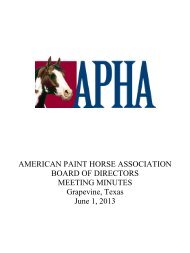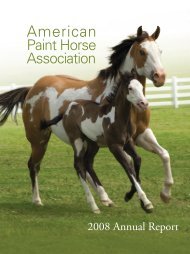Coat Color Genetics - Press - American Paint Horse Association
Coat Color Genetics - Press - American Paint Horse Association
Coat Color Genetics - Press - American Paint Horse Association
Create successful ePaper yourself
Turn your PDF publications into a flip-book with our unique Google optimized e-Paper software.
y the Native <strong>American</strong> tribes of<br />
the Great Plains. Most sabinos that<br />
are largely white are very speckled<br />
and roaned, and some can be confused<br />
with Appaloosas.<br />
Some sabinos are quite white<br />
and survive, which points to this<br />
being entirely different from the<br />
overo that results in lethal white<br />
foals when homozygous. Sabino,<br />
by itself, is not associated with<br />
lethal white foals.<br />
Splashed White Overo<br />
Splashed white is the least common<br />
of the spotting patterns,<br />
although it is increasing in frequency<br />
as breeders use more splashed<br />
white horses in their breeding programs.<br />
The pattern usually makes the<br />
horse look as though it has been<br />
dipped in white paint. The legs are<br />
usually white, as are the bottom<br />
portions of the body. The head is<br />
also usually white and the eyes are<br />
frequently blue.<br />
The edges of the white are typically<br />
crisp and clean, with no roaning.<br />
Some splashed whites have<br />
dark toplines, but on some the<br />
white crosses the topline.<br />
Recent genetic evidence suggests<br />
that the splashed white pattern is<br />
caused by a dominant gene,<br />
because splashed white foals have<br />
resulted from splashed white to<br />
non-splashed white matings.<br />
Some people have observed that<br />
many splashed white horses are<br />
deaf. This is not much of a problem<br />
if the trainer realizes the limitations<br />
of the horse in question and modifies<br />
the training program to meet<br />
the horse’s special needs. Many of<br />
these horses go on to lead normal<br />
and productive lives.<br />
Because no homozygous<br />
splashed white horses have ever<br />
been documented, researchers suspect<br />
that this is another gene that<br />
cannot exist in homozygous form.<br />
If this is true, the loss of hearing<br />
probably occurs early in gestation<br />
rather than at term. Because of this,<br />
the best strategy for producing<br />
splashed white horses is to mate<br />
them to horses without the<br />
splashed white pattern.<br />
Tovero<br />
While each of the <strong>Paint</strong><br />
patterns—tobiano, frame<br />
overo, sabino and<br />
splashed white—can<br />
mark a horse on its<br />
own, many horses sport<br />
combinations of these. When these<br />
patterns combine, the result is a horse<br />
with a pattern that can sometimes be<br />
difficult to classify.<br />
When a mating between a tobiano and an<br />
overo produces an offspring that exhibits<br />
characteristics of both patterns, APHA recognizes<br />
the resulting pattern as tovero (pronounced:<br />
tow vair´ oh). (It should also be<br />
noted that, while considerably rarer, a cross<br />
between a tobiano and a solid can also produce<br />
a tovero.)<br />
In this instance, the combined patterns pick<br />
up the white from each of their individual components.<br />
They are then genetically mixed to<br />
create a combination pattern on the horse’s<br />
coat. For instance, a horse with a frame overo<br />
sire might inherit a white framed area on each<br />
of its sides. If the horse had a tobiano dam, it<br />
might inherit a white, blanket-like pattern that<br />
covers its entire back. The result might look<br />
something like the tovero shown on this page,<br />
which is mostly white.<br />
Many of the combinations are called tovero<br />
because most are tobiano plus one of the<br />
other patterns.<br />
Although the word tovero has been a part<br />
of APHA’s vocabulary from the onset of the<br />
registry, it remains to this day somewhat of an<br />
ambiguous term.<br />
Just as there are extremes within the<br />
tobiano and overo coat patterns—from mostly<br />
dark to mostly white—so are there extremes<br />
within the tovero pattern.<br />
At one end of the spectrum—the mostly dark<br />
one—are those toveros that closely resemble<br />
tobianos except for their face markings, which<br />
show an overo influence. At the opposite end—<br />
the mostly white one—are those toveros whose<br />
only dark pigmentation might appear around<br />
the ears, eyes or chestnuts.<br />
In between those two extremes is the horse<br />
that can be termed the “typical” tovero, distinguished<br />
by the four basic coat characteristics<br />
shown below. Typical toveros have:<br />
1. Dark pigmentation around the ears, which<br />
may expand to cover the forehead and/or<br />
eyes.<br />
2. One or both eyes blue.<br />
3. Dark pigmentation around the mouth,<br />
which may extend up the sides of the face<br />
and form spots.<br />
4. Chest spot(s) varying in size. These may<br />
also extend up the neck.<br />
5. Flank spot(s) varying in size. These are<br />
often accompanied by smaller spots that<br />
extend forward across the barrel and up<br />
over the loin.<br />
6. Spots, varying in size, at the base of the tail.<br />
Identifying the tovero pattern is not an easy<br />
task. During the <strong>Association</strong>’s early years,<br />
some toveros were mistakenly classified as<br />
tobianos or overos. In defense of the people<br />
who misclassified those animals, two points<br />
must be made. First of all, during the registry’s<br />
infancy, the pattern was much rarer than it is<br />
now. There simply weren’t enough toveros<br />
being registered to establish a workable profile<br />
of what their physical characteristics were.<br />
Second, it had not yet been firmly established<br />
how these horses would breed—what<br />
patterns they would produce that would prove<br />
or disprove their classification.<br />
More than 40 years of <strong>Association</strong> growth<br />
has alleviated both of these conditions, and<br />
the APHA Registration Department now has<br />
the situation well in hand.<br />
Typical Tovero Patterns<br />
Tovero<br />
APHA <strong>Coat</strong> <strong>Color</strong> <strong>Genetics</strong> Guide • 3




